Table of Contents
- 1. Overview
- 2. Setting up springdoc-openapi
- 3. Setting up springdoc-openapi With Swagger UI
- 4. Integrating springdoc-openapi With Spring WebFlux
- 5. Exposing Pagination Information
- 6. Using springdoc-openapi Maven Plugin
- 7. Automatic Document Generation Using JSR-303 Bean Validation
- 8. Generate Documentation Using @ControllerAdvice and @ResponseStatus
- 9. Generate Documentation Using @Operation and @ApiResponses
- 10. Kotlin Support
- 11. Conclusion
1. Overview
Documentation is an essential part of building REST APIs. In this tutorial, we’ll take a look at SpringDoc — a tool that simplifies the generation and maintenance of API docs based on the OpenAPI 3 specification for Spring Boot 1.x and 2.x applications.
2. Setting up springdoc-openapi
To have springdoc-openapi automatically generate the OpenAPI 3 specification docs for our API, we simply add the springdoc-openapi-ui dependency to our pom.xml:
<dependency>
<groupId>org.springdoc</groupId>
<artifactId>springdoc-openapi-ui</artifactId>
<version>1.5.2</version>
</dependency>
Then when we run our application, the OpenAPI descriptions will be available at the path /v3/api-docs by default:
http://localhost:8080/v3/api-docs/
To use a custom path, we can indicate in the application.properties file:
springdoc.api-docs.path=/api-docs
Now we’ll be able to access the docs at:
http://localhost:8080/api-docs/
The OpenAPI definitions are in JSONformat by default. For yaml format, we can obtain the definitions at:
http://localhost:8080/api-docs.yaml
3. Setting up springdoc-openapi With Swagger UI
Besides generating the OpenAPI 3 specification itself, we can integrate springdoc-openapi with Swagger UI so that we can interact with our API specification and exercise the endpoints.
3.1. Maven Dependency
All we have to do to set up springdoc-openapi with Swagger UI is to add the dependency springdoc-openapi-ui to the project’s pom.xml:
<dependency>
<groupId>org.springdoc</groupId>
<artifactId>springdoc-openapi-ui</artifactId>
<version>1.5.2</version>
</dependency>
Now we can access the API documentation at:
http://localhost:8080/swagger-ui.html
3.2. Support for swagger-ui Properties
Springdoc-openapi also supports swagger-ui properties. These can be used as Spring Boot properties, with the prefix springdoc.swagger-ui.
For example, let’s customize the path of our API documentation. We can do this by modifying our application.properties to include:
springdoc.swagger-ui.path=/swagger-ui-custom.html
So now our API documentation will be available at http://localhost:8080/swagger-ui-custom.html.
As another example, to sort the API paths in order of their HTTP methods, we can add:
springdoc.swagger-ui.operationsSorter=method
3.3. Sample API
Suppose our application has a controller for managing Books:
@RestController
@RequestMapping("/api/book")
public class BookController {
@Autowired
private BookRepository repository;
@GetMapping("/{id}")
public Book findById(@PathVariable long id) {
return repository.findById(id)
.orElseThrow(() -> new BookNotFoundException());
}
@GetMapping("/")
public Collection<Book> findBooks() {
return repository.getBooks();
}
@PutMapping("/{id}")
@ResponseStatus(HttpStatus.OK)
public Book updateBook(
@PathVariable("id") final String id, @RequestBody final Book book) {
return book;
}
}
Then when we run our application, we can view the documentation at:
http://localhost:8080/swagger-ui-custom.html
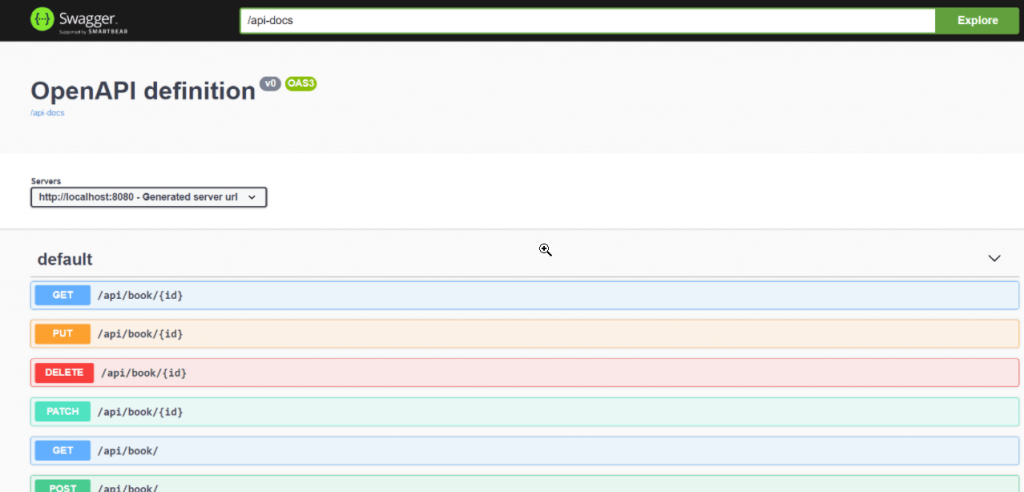
Let’s drill down to the /api/book endpoint and see the details for its request and response:
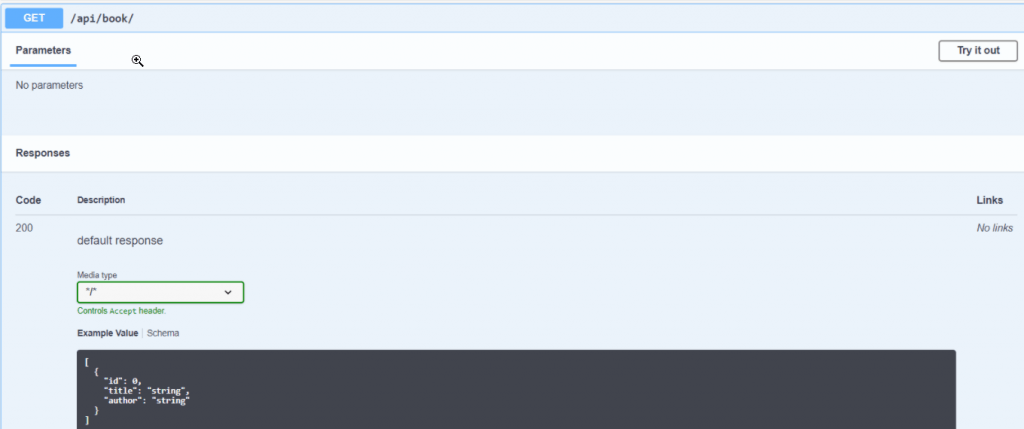
4. Integrating springdoc-openapi With Spring WebFlux
We can integrate springdoc-openapi and Swagger UI in a Spring WebFlux project by adding springdoc-openapi-webflux-ui:
<dependency>
<groupId>org.springdoc</groupId>
<artifactId>springdoc-openapi-webflux-ui</artifactId>
<version>1.5.2</version>
</dependency>
As before, the docs will be accessible at:
http://localhost:8080/swagger-ui.html
In order to customize the path, we could again add the springdoc.swagger-ui.path property in our application.properties.
5. Exposing Pagination Information
Spring Data JPA integrates with Spring MVC quite seamlessly. One example of such integration is Pageable support:
@GetMapping("/filter")
public Page<Book> filterBooks(Pageable pageable) {
return repository.getBooks(pageable);
}
At first we might expect SpringDoc to add page, size, and sort query parameters to the generated documentation. However, by default, SpringDoc does not meet this expectation. In order to unlock this feature, we should add the springdoc-openapi-data-rest dependency:
<dependency>
<groupId>org.springdoc</groupId>
<artifactId>springdoc-openapi-data-rest</artifactId>
<version>1.5.2</version>
</dependency>
Now it adds the expected query parameters to the documentation:
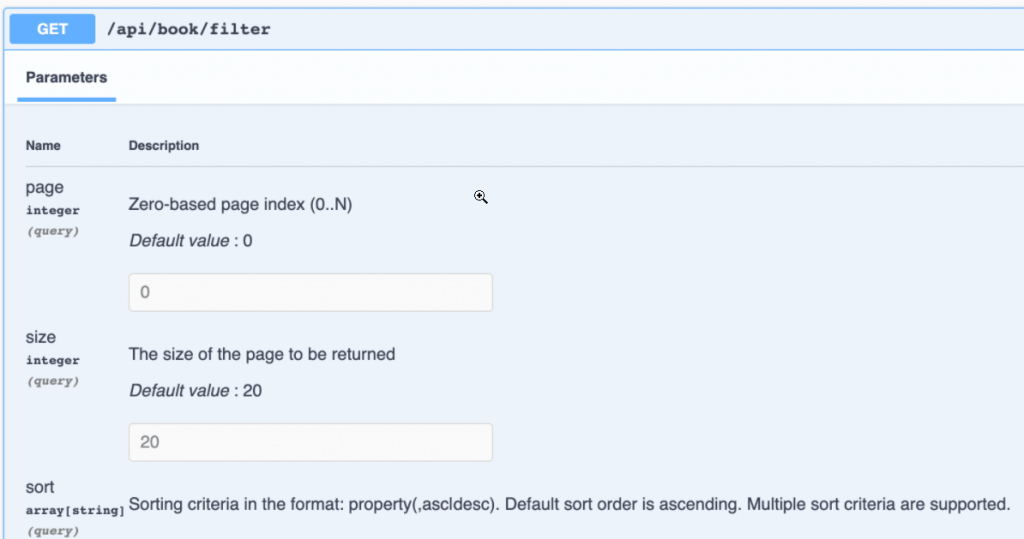
6. Using springdoc-openapi Maven Plugin
The springdoc-openapi library provides a Maven plugin springdoc-openapi-maven-plugin for generating OpenAPI descriptions in json and yaml formats.
The springdoc-openapi-maven-plugin plugin works with the spring-boot-maven plugin. Maven runs the openapi plugin during the integration-test phase.
Let’s see how we can configure the plugin in our pom.xml:
<plugin>
<groupId>org.springframework.boot</groupId>
<artifactId>spring-boot-maven-plugin</artifactId>
<version>2.3.3.RELEASE</version>
<executions>
<execution>
<id>pre-integration-test</id>
<goals>
<goal>start</goal>
</goals>
</execution>
<execution>
<id>post-integration-test</id>
<goals>
<goal>stop</goal>
</goals>
</execution>
</executions>
</plugin>
<plugin>
<groupId>org.springdoc</groupId>
<artifactId>springdoc-openapi-maven-plugin</artifactId>
<version>0.2</version>
<executions>
<execution>
<phase>integration-test</phase>
<goals>
<goal>generate</goal>
</goals>
</execution>
</executions>
</plugin>
We can also configure the plugin to use custom values:
<plugin>
<executions>
.........
</executions>
<configuration>
<apiDocsUrl>http://localhost:8080/v3/api-docs</apiDocsUrl>
<outputFileName>openapi.json</outputFileName>
<outputDir>${project.build.directory}</outputDir>
</configuration>
</plugin>
Let’s take a closer look at the parameters that we can configure for the plugin:
- apiDocsUrl – URL where the docs can be accessed in JSON format, with a default of http://localhost:8080/v3/api-docs
- outputFileName – Name of the file where the definitions are stored, defaults to openapi.json
- outputDir – Absolute path for the directory where the docs are stored, by default ${project.build.directory}
7. Automatic Document Generation Using JSR-303 Bean Validation
When our model includes JSR-303 bean validation annotations, such as @NotNull, @NotBlank, @Size, @Min, and @Max, the springdoc-openapi library uses them to generate additional schema documentation for the corresponding constraints.
Let’s see an example using our Book bean:
public class Book {
private long id;
@NotBlank
@Size(min = 0, max = 20)
private String title;
@NotBlank
@Size(min = 0, max = 30)
private String author;
}
Now the documentation generated for the Book bean is a little more informative:
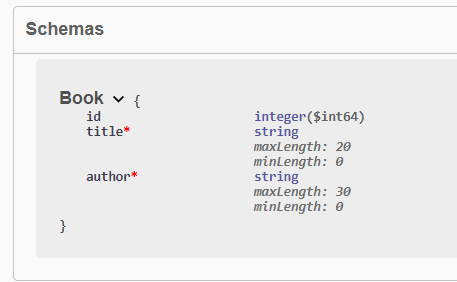
8. Generate Documentation Using @ControllerAdvice and @ResponseStatus
Using @ResponseStatus on methods in a @RestControllerAdvice class will automatically generate documentation for the response codes. In this @RestControllerAdvice class, the two methods are annotated with @ResponseStatus:
@RestControllerAdvice
public class GlobalControllerExceptionHandler {
@ExceptionHandler(ConversionFailedException.class)
@ResponseStatus(HttpStatus.BAD_REQUEST)
public ResponseEntity<String> handleConnversion(RuntimeException ex) {
return new ResponseEntity<>(ex.getMessage(), HttpStatus.BAD_REQUEST);
}
@ExceptionHandler(BookNotFoundException.class)
@ResponseStatus(HttpStatus.NOT_FOUND)
public ResponseEntity<String> handleBookNotFound(RuntimeException ex) {
return new ResponseEntity<>(ex.getMessage(), HttpStatus.NOT_FOUND);
}
}
As a result, we can now see the documentation for the response codes 400 and 404:
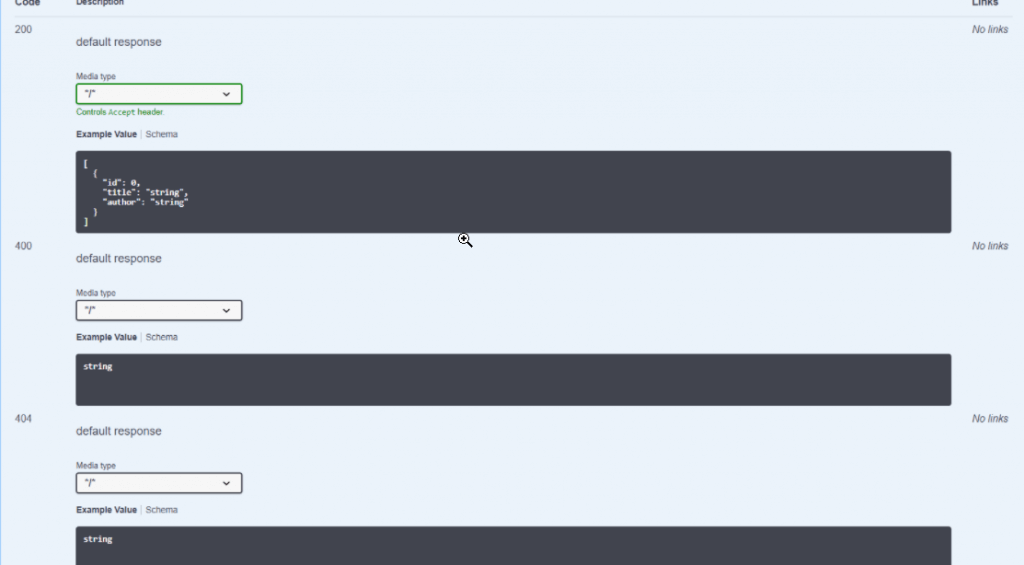
9. Generate Documentation Using @Operation and @ApiResponses
Next let’s see how we can add some description to our API using a couple of OpenAPI-specific annotations.
In order to do that, we’ll annotate our controller’s /api/book/{id} endpoint with @Operation and @ApiResponses:
@Operation(summary = "Get a book by its id")
@ApiResponses(value = {
@ApiResponse(responseCode = "200", description = "Found the book",
content = { @Content(mediaType = "application/json",
schema = @Schema(implementation = Book.class)) }),
@ApiResponse(responseCode = "400", description = "Invalid id supplied",
content = @Content),
@ApiResponse(responseCode = "404", description = "Book not found",
content = @Content) })
@GetMapping("/{id}")
public Book findById(@Parameter(description = "id of book to be searched")
@PathVariable long id) {
return repository.findById(id).orElseThrow(() -> new BookNotFoundException());
}
Here’s the effect:
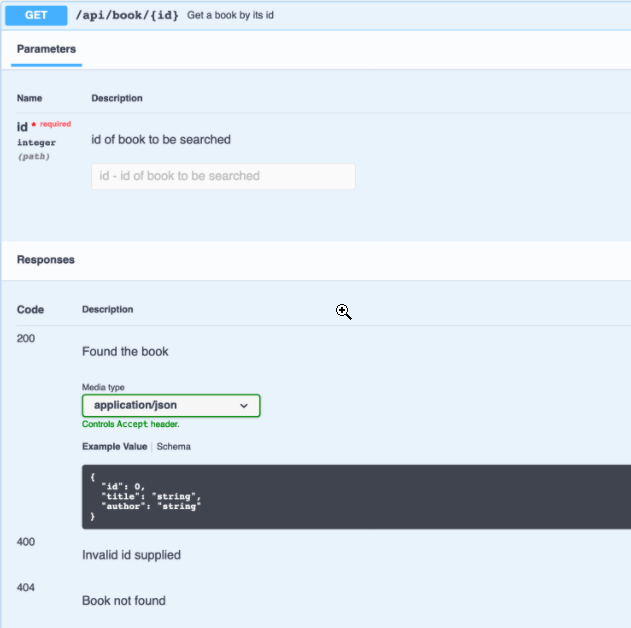
As we can see, the text we added to @Operation is placed at the API operation level. Similarly, the description added to various @ApiResponse elements in the @ApiResponses container annotation is also visible here, adding meaning to our API responses.
Evidently, we do not get any schema for the responses 400 and 404 above. As we defined an empty @Content for them, only their descriptions are displayed.
10. Kotlin Support
Since Spring Boot 2.x has first-class support for Kotlin, SpringDoc supports this JVM language out of the box for Boot 2.x applications.
To see this in action, we’ll create a simple Foo API in Kotlin.
After the initial setup, we’ll add a data class and a controller. We’ll add them in a sub-package of our Boot App so that when it’s run, it picks our FooController up along with the earlier BookController:
@Entity
data class Foo(
@Id
val id: Long = 0,
@NotBlank
@Size(min = 0, max = 50)
val name: String = ""
)
@RestController
@RequestMapping("/")
class FooController() {
val fooList: List = listOf(Foo(1, "one"), Foo(2, "two"))
@Operation(summary = "Get all foos")
@ApiResponses(value = [
ApiResponse(responseCode = "200", description = "Found Foos", content = [
(Content(mediaType = "application/json", array = (
ArraySchema(schema = Schema(implementation = Foo::class)))))]),
ApiResponse(responseCode = "400", description = "Bad request", content = [Content()]),
ApiResponse(responseCode = "404", description = "Did not find any Foos", content = [Content()])]
)
@GetMapping("/foo")
fun getAllFoos(): List = fooList
}
Now when we hit our API documentation URL, we’ll see the Foo API as well:
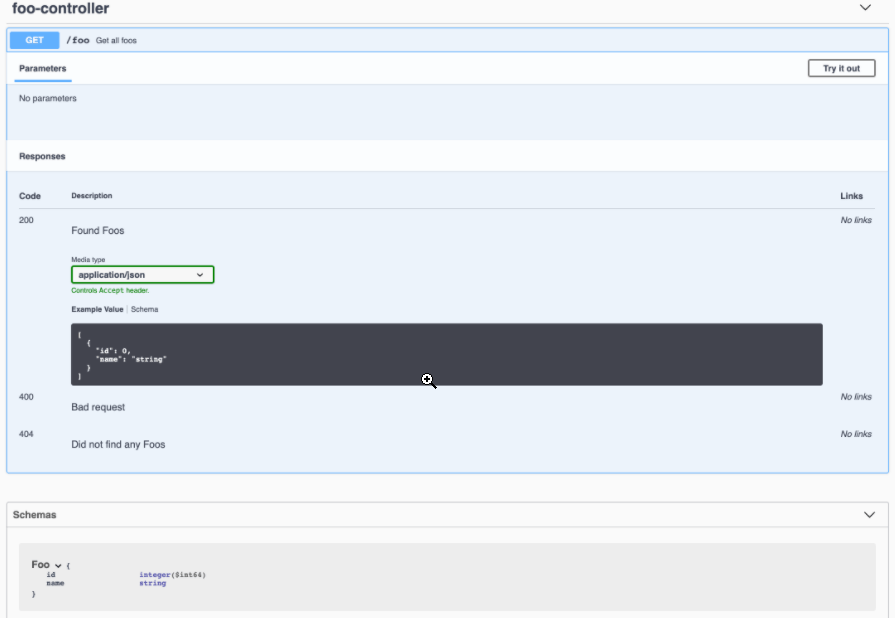
To enhance the support of Kotlin types, we can add this dependency:
<dependency>
<groupId>org.springdoc</groupId>
<artifactId>springdoc-openapi-kotlin</artifactId
<version>1.3.9</version>
</dependency>
After that, our Foo schema will look more informative, as it did when we added JSR-303 Bean Validation:
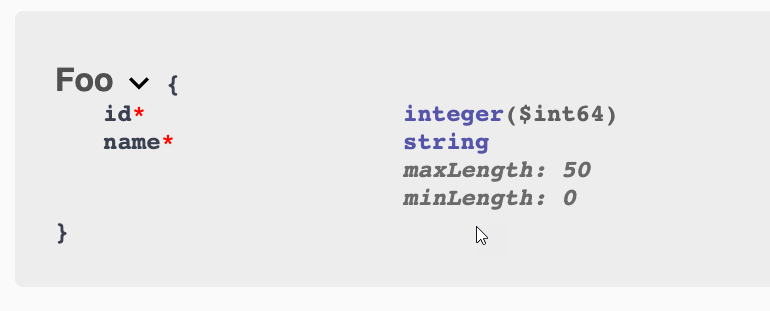
11. Conclusion
In this article, we learned to set up springdoc-openapi in our projects. Then we saw how to integrate springdoc-openapi with the Swagger UI. We also saw how to do this with Spring Webflux projects.
Next we used the springdoc-openapi Maven Plugin to generate OpenAPI definitions for our APIs, and we saw how to expose paging and sorting information from Spring Data. After that, we looked at how springdoc-openapi generates documentation automatically using JSR 303 bean validation annotations and the @ResponseStatus annotations in @ControllerAdvice class.
We also learned how to add a description to our API using a few OpenAPI-specific annotations. Finally, we took a peek at OpenAPI’s support of Kotlin.
The springdoc-openapi generates API documentation as per OpenAPI 3 specification. Moreover, it also handles the Swagger UI configuration for us, making API document generation a fairly simple task.
As always, the code is available over on GitHub.

